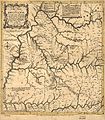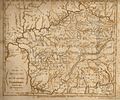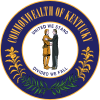Portal:Kentucky
The Kentucky Portal  Kentucky (US: /kənˈtʌki/ kən-TUK-ee, UK: /kɛn-/ ken-), officially the Commonwealth of Kentucky, is a landlocked state in the Southeastern region of the United States. Kentucky borders Illinois, Indiana, and Ohio to the north, West Virginia to the northeast, Virginia to the east, Tennessee to the south, and Missouri to the west. Its northern border is defined by the Ohio River. Its capital is Frankfort and its largest city is Louisville. As of 2020, the population was approximately 4.5 million. Kentucky was admitted into the Union as the 15th state on June 1, 1792, splitting from Virginia in the process. It is known as the "Bluegrass State", a nickname based on Kentucky bluegrass, a species of green grass introduced by European settlers for the purpose of grazing in pastures, which has supported the thoroughbred horse industry in the center of the state. Historically, Kentucky had excellent farming conditions, which led to the development of large tobacco plantations similar to those in Virginia and North Carolina in the central and western parts of the state that utilized enslaved labor during the Antebellum South and Civil War periods. Kentucky ranks fifth nationally in goat farming, eight in beef cattle production, and 14th in corn production. While Kentucky has been a long-standing major center for the tobacco industry, the state's economy has diversified in multiple non-agricultural sectors, including auto manufacturing, energy fuel production, and medical facilities. The state ranks 4th among US states in the number of automobiles and trucks assembled. Kentucky is one of several states considered a part of the Upland South. (Full article...) Entries here consist of Good and Featured articles, which meet a core set of high editorial standards.
 Augustus Owsley Stanley I (May 21, 1867 – August 12, 1958) was an American politician from Kentucky. A member of the Democratic Party, he served as the 38th governor of Kentucky and also represented the state in both the U.S. House of Representatives and the U.S. Senate. From 1903 to 1915, Stanley represented Kentucky's 2nd congressional district in the House of Representatives, where he gained a reputation as a progressive reformer. Beginning in 1904, he called for an antitrust investigation of the American Tobacco Company, claiming they were a monopsony that drove down prices for the tobacco farmers of his district. As a result of his investigation, the Supreme Court of the United States ordered the breakup of the American Tobacco Company in 1911. Stanley also chaired a committee that conducted an antitrust investigation of U.S. Steel, which brought him national acclaim. Many of his ideas were incorporated into the Clayton Antitrust Act. During an unsuccessful senatorial bid in 1914, Stanley assumed an anti-prohibition stance. This issue would dominate his political career for more than a decade and put him at odds with J. C. W. Beckham, the leader of the pro-temperance faction of the state's Democratic Party. In 1915, Stanley ran for governor, defeating his close friend Edwin P. Morrow by just over 400 votes in the closest gubernatorial race in the state's history. Historian Lowell H. Harrison called Stanley's administration the apex of the Progressive Era in Kentucky. Among the reforms adopted during his tenure were a state antitrust law, a campaign finance reform law, and a workman's compensation law. In 1918, Stanley was chosen as the Democratic nominee to succeed the recently deceased senator Ollie M. James. Stanley was elected, but did not resign as governor to take the seat until May 1919 and accomplished little in his single term. He lost his re-election bid to Frederic M. Sackett in the 1924 Republican landslide and never again held elected office. He died in Washington, D.C., on August 12, 1958. (Full article...)Selected article -Lake Cumberland is a reservoir in Clinton, Pulaski, Russell, Wayne, and Laurel, counties in Kentucky. The primary reasons for its construction were a means for flood control and the production of hydroelectric power. Its shoreline measures 1,255 miles (2,020 km) and the lake covers 65,530 acres (265 km2) at the maximum power pool elevation. The reservoir ranks 9th in the U.S. in size, with a capacity of 6,100,000 acre-feet (7.5 km3) of water, enough to cover the entire Commonwealth of Kentucky with 3 inches (76 mm) of water. The main lake is 101 miles (163 km) long and over one mile (1.6 km) across at its widest point. The lake has become a major source of tourism and an economic engine for south-central Kentucky. As of September 2011 Lake Cumberland was approximately 43 feet (13 m) below its normal level due to leakage in the earthen part of the dam, but repairs were completed in 2013 and officials estimated that lake levels would be back to normal by 2014–2015. As of April 18, 2015, the lake is back to full summer pool. (Full article...)General images -The following are images from various Kentucky-related articles on Wikipedia.
Did you know -
Related portalsTopicsNational Register of Historic Places listings in Kentucky by county
Largest citiesCategoriesNew articlesThis list was generated from these rules. Questions and feedback are always welcome! The search is being run daily with the most recent ~14 days of results. Note: Some articles may not be relevant to this project.
Rules | Match log | Results page (for watching) | Last updated: 2024-05-22 21:34 (UTC) Note: The list display can now be customized by each user. See List display personalization for details.
WikiProjectsTasks
Associated WikimediaThe following Wikimedia Foundation sister projects provide more on this subject:
Sources
Discover Wikipedia using portals |












































